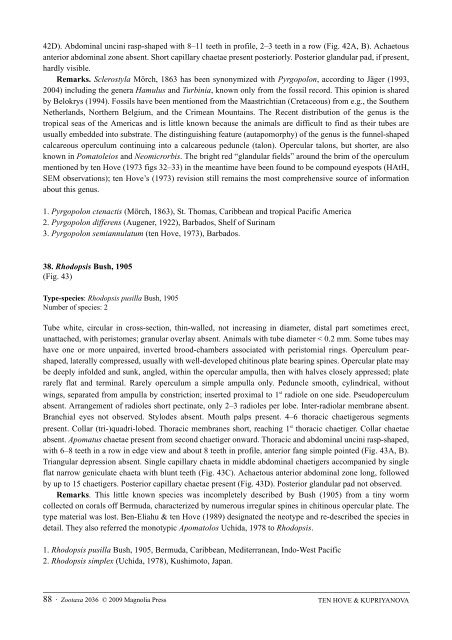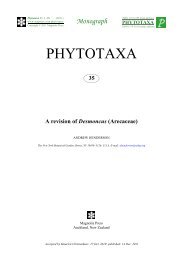Zootaxa, Taxonomy of Serpulidae (Annelida ... - Magnolia Press
Zootaxa, Taxonomy of Serpulidae (Annelida ... - Magnolia Press
Zootaxa, Taxonomy of Serpulidae (Annelida ... - Magnolia Press
You also want an ePaper? Increase the reach of your titles
YUMPU automatically turns print PDFs into web optimized ePapers that Google loves.
42D). Abdominal uncini rasp-shaped with 8–11 teeth in pr<strong>of</strong>ile, 2–3 teeth in a row (Fig. 42A, B). Achaetous<br />
anterior abdominal zone absent. Short capillary chaetae present posteriorly. Posterior glandular pad, if present,<br />
hardly visible.<br />
Remarks. Sclerostyla Mörch, 1863 has been synonymized with Pyrgopolon, according to Jäger (1993,<br />
2004) including the genera Hamulus and Turbinia, known only from the fossil record. This opinion is shared<br />
by Belokrys (1994). Fossils have been mentioned from the Maastrichtian (Cretaceous) from e.g., the Southern<br />
Netherlands, Northern Belgium, and the Crimean Mountains. The Recent distribution <strong>of</strong> the genus is the<br />
tropical seas <strong>of</strong> the Americas and is little known because the animals are difficult to find as their tubes are<br />
usually embedded into substrate. The distinguishing feature (autapomorphy) <strong>of</strong> the genus is the funnel-shaped<br />
calcareous operculum continuing into a calcareous peduncle (talon). Opercular talons, but shorter, are also<br />
known in Pomatoleios and Neomicrorbis. The bright red “glandular fields” around the brim <strong>of</strong> the operculum<br />
mentioned by ten Hove (1973 figs 32–33) in the meantime have been found to be compound eyespots (HAtH,<br />
SEM observations); ten Hove’s (1973) revision still remains the most comprehensive source <strong>of</strong> information<br />
about this genus.<br />
1. Pyrgopolon ctenactis (Mörch, 1863), St. Thomas, Caribbean and tropical Pacific America<br />
2. Pyrgopolon differens (Augener, 1922), Barbados, Shelf <strong>of</strong> Surinam<br />
3. Pyrgopolon semiannulatum (ten Hove, 1973), Barbados.<br />
38. Rhodopsis Bush, 1905<br />
(Fig. 43)<br />
Type-species: Rhodopsis pusilla Bush, 1905<br />
Number <strong>of</strong> species: 2<br />
Tube white, circular in cross-section, thin-walled, not increasing in diameter, distal part sometimes erect,<br />
unattached, with peristomes; granular overlay absent. Animals with tube diameter < 0.2 mm. Some tubes may<br />
have one or more unpaired, inverted brood-chambers associated with peristomial rings. Operculum pearshaped,<br />
laterally compressed, usually with well-developed chitinous plate bearing spines. Opercular plate may<br />
be deeply infolded and sunk, angled, within the opercular ampulla, then with halves closely appressed; plate<br />
rarely flat and terminal. Rarely operculum a simple ampulla only. Peduncle smooth, cylindrical, without<br />
wings, separated from ampulla by constriction; inserted proximal to 1 st radiole on one side. Pseudoperculum<br />
absent. Arrangement <strong>of</strong> radioles short pectinate, only 2–3 radioles per lobe. Inter-radiolar membrane absent.<br />
Branchial eyes not observed. Stylodes absent. Mouth palps present. 4–6 thoracic chaetigerous segments<br />
present. Collar (tri-)quadri-lobed. Thoracic membranes short, reaching 1 st thoracic chaetiger. Collar chaetae<br />
absent. Apomatus chaetae present from second chaetiger onward. Thoracic and abdominal uncini rasp-shaped,<br />
with 6–8 teeth in a row in edge view and about 8 teeth in pr<strong>of</strong>ile, anterior fang simple pointed (Fig. 43A, B).<br />
Triangular depression absent. Single capillary chaeta in middle abdominal chaetigers accompanied by single<br />
flat narrow geniculate chaeta with blunt teeth (Fig. 43C). Achaetous anterior abdominal zone long, followed<br />
by up to 15 chaetigers. Posterior capillary chaetae present (Fig. 43D). Posterior glandular pad not observed.<br />
Remarks. This little known species was incompletely described by Bush (1905) from a tiny worm<br />
collected on corals <strong>of</strong>f Bermuda, characterized by numerous irregular spines in chitinous opercular plate. The<br />
type material was lost. Ben-Eliahu & ten Hove (1989) designated the neotype and re-described the species in<br />
detail. They also referred the monotypic Apomatolos Uchida, 1978 to Rhodopsis.<br />
1. Rhodopsis pusilla Bush, 1905, Bermuda, Caribbean, Mediterranean, Indo-West Pacific<br />
2. Rhodopsis simplex (Uchida, 1978), Kushimoto, Japan.<br />
88 · <strong>Zootaxa</strong> 2036 © 2009 <strong>Magnolia</strong> <strong>Press</strong><br />
TEN HOVE & KUPRIYANOVA
















